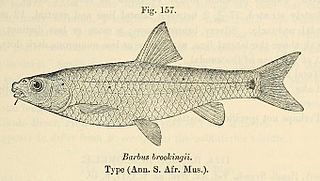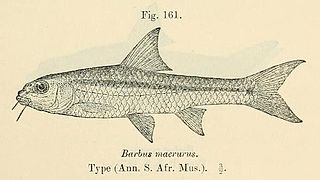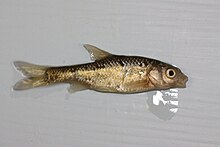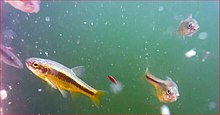
The clipper barb or Congo barb is a freshwater and brackish tropical fish belonging to the minnow family (Cyprinidae). Its native habitat is from Côte d'Ivoire through the Chad Basin to Nigeria and Cameroon. It was originally described as Barbus callipterus by Boulenger in 1907.

The loach minnow is a species of freshwater fish. It is a member of the carp family of order Cypriniformes. It occurs in streams and small rivers throughout the Gila River and San Pedro River systems in Arizona, New Mexico, and Sonora; it is now considered extinct in Mexico.

The lake chub is a freshwater cyprinid fish found in Canada and in parts of the United States. Of all North American minnows, it is the one with the northernmost distribution. Its genus, Couesius is considered monotypic today. The genus was named after Elliott Coues, who collected the holotype specimen.
The Twee River redfin or simply Twee redfin is a ray-finned fish species in the family Cyprinidae. It is placed with the South African redfins in Pseudobarbus. It is tetraploid. Its closest living relative is probably the Clanwilliam redfin.

Enteromius litamba is a ray-finned fish species in the family Cyprinidae. It has long been placed in Barbus, the "wastebin genus" for barbs, by default, and this is still being done by the IUCN. However, the species is increasingly being restored by some taxonomists to the related yellowfish genus Labeobarbus, others place it in the genus Enteromius. It is presumably hexaploid like the other yellowfish.
The hornyhead chub is a small species of minnow in the family Cyprinidae of order Cypriniformes. It mainly inhabits small rivers and streams of the northern central USA, up into Canada. The adults inhabit faster, rocky pools of rivers.

Semotilus atromaculatus, known as the creek chub or the common creek chub, is a small minnow, a freshwater fish found in the eastern US and Canada. Differing in size and color depending on origin of development, the creek chub can usually be defined by a dark brown body with a black lateral line spanning horizontally across the body. It lives primarily within streams and rivers. Creek chubs attain lengths of 2-6 inches with larger specimens of up to 12 inches possible. The genus name Semotilus derives from the Greek word sema, and atromaculatus comes from the Latin word "black spots".

The border barb is a ray-finned fish species in the family Cyprinidae. It is placed with the South African redfins in Pseudobarbus. Like Pseudobarbus. It is tetraploid.

The Cambodian logsucker, also known as stonelapping minnow or false Siamese algae eater, is a species of ray-finned fish in the genus Garra. It lives in Southeast Asia.

Eastern blacknose dace is a species of ray-finned fish in the genus Rhinichthys. Its name originates from the Old French word "dars" which is the nominative form of the word "dart" in reference to their swimming pattern. The western blacknose dace formerly was considered conspecific. While morphologically the two species are not significantly different, they are allopatric. The eastern blacknose dace is found across the southeast portion of Canada and down along the United States' east coast. It is dark brown to olive on its dorsal surface and silvery white below, the two shades separated by the darkly pigmented lateral line. In the breeding season, males develop darker pigmentation and an orange lateral line. Blacknose dace live in rocky streams and rivers where they feed upon small invertebrates and microscopic biological matter and provide forage for larger fish.
The sickle barb is a species of ray-finned fish in the genus Enteromius. it gets its common name from the sickle shaped anal fin of mature males, they are normally a translucent brown colour with a spot on the caudal peduncle but in breeding condition the males take on a rosy hue. It is a common and widespread species of swamps and shallow waters, including floodplains, in central Africa from the Congo Basin to the Zambezi. It is harvested commercially for food and for the aquarium trade and in some areas, such as Katanga, pollution may be a threat but it is a common and widespread small fish and is not considered to be globally threatened.

Jae barb or Dja barb,, is a species of cyprinid fish which like other sub-Saharan "barbs" was formerly placed in the genus Barbus, it has now been reallocated to Enteromius.

The papermouth, also known as the silverfish is a species of ray-finned fish in the genus Enteromius.
The goldie barb is a species of ray-finned fish in the genus Enteromius. It is endemic to the Eastern Cape in South Africa where it is threatened by the introduction of non-native fish species.

Threespot barb is a species of cyprinid fish in the large genus Enteromius. It has a wide distribution in sub-Saharan Africa from the Congo Basin east to the Indian Ocean coast of Tanzania and south to KwaZulu Natal in South Africa. It occurs in shallow water around river inflows or near swampy areas. It is a habitat generalist and also hardy, but it prefers vegetated areas. It feeds on insects and other small animals. It is often caught for use as bait by anglers fishing for tigerfish. It breeds during the summer rainy season when shoals of fertile adults migrate upstream when the rivers are in spate following rain. A single females may produce as many as 8,000 eggs.

The slender barb or longbeard barb is a species of ray-finned fish in the genus Enteromius which has a wide distribution from the Democratic Republic of the Congo to South Africa.

The ironcolor shiner is a species of freshwater ray-finned fish from the family Cyprinidae, the minnows and carps. It is a widespread species in streams and rivers in eastern North America.

The brassy minnow is a species of fish belonging to the family Cyprinidae. The family Cyprinidae consists of mainly freshwater minnows and carps. The fish gets its scientific name from the Greek word Hybognathus, meaning bulging jaw, and hankinsoni from the American scientist, T.L. Hankinson. It is commonly found throughout the northern United States and Canada.

Mylocheilus caurinus, the peamouth, peamouth chub, redmouth sucker or northwestern dace, is a species of freshwater ray-finned fish from the family Cyprinidae, the carps and minnows, that is found in western North America. It is the only species in its genus.

The slim minnow is a species of freshwater ray-finned fish from the family Cyprinidae, the carps and minnows which is endemic to the United States, in Ozarks of Arkansas, Kansas, Missouri, and Oklahoma.



















